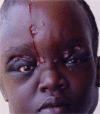Head and neck mycetoma: the mycetoma research centre experience
- PMID: 25768090
- PMCID: PMC4359145
- DOI: 10.1371/journal.pntd.0003587
Head and neck mycetoma: the mycetoma research centre experience
Abstract
Mycetoma is a unique neglected tropical disease which is endemic in what is known as the "mycetoma belt". The disease has many devastating impacts on patients and communities in endemic area and is characterised by massive deformity, destruction and disability. Mycetoma is commonly seen in the foot and hand and less frequent in other parts of the body. Mycetoma of the head and neck is a rarity and is associated with high morbidity and even mortality if not treated early. In this communication we report on 49 patients with head and neck mycetoma followed up at the Mycetoma Research Centre in Khartoum. Most of the reported patients had actinomycetoma and the majority were young adult males from mycetoma endemic areas in the Sudan. Most of them were students, farmers and workers. Prior to presentation the majority had long disease duration and the cause was multifactorial. Advanced disease with massive lesion, deformity and disability was the common presentation. There was no obvious history of local trauma, familial tendency or other predisposing factor identified in this group of patients. MRI and CT scan were the most accurate diagnostic tools to determine the disease extent. The treatment outcome was rather poor and characterised by low cure rate, poor outcome and high follows-up dropout. Such a gloomy outcome calls for structured and objective health education programs.
Conflict of interest statement
The authors have declared that no competing interests exist.
Figures






References
-
- Fahal AH, Hassan MA (1992) Mycetoma. Br J Surg 79: 1138–1141. - PubMed
-
- Fahal AH (2004) Mycetoma: a thorn in the flesh. Trans R Soc Trop Med Hyg 98: 3–11. - PubMed
-
- Ahmed AO, van Leeuwen W, Fahal A, van de Sande W, Verbrugh H, et al. (2004) Mycetoma caused by Madurella mycetomatis: a neglected infectious burden. Lancet Infect Dis 4: 566–574. - PubMed
-
- van Belkum A, Fahal A, van de Sande WW (2013) Mycetoma caused by Madurella mycetomatis: a completely neglected medico-social dilemma. Adv Exp Med Biol 764: 179–189. - PubMed
MeSH terms
LinkOut - more resources
Full Text Sources
Other Literature Sources

